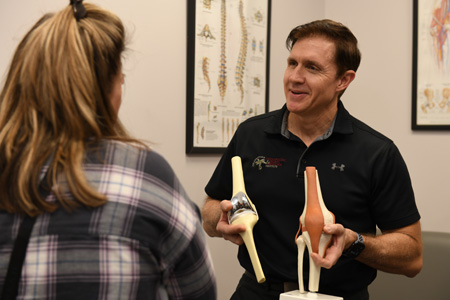Knee Strains & Sprains
![]() These two terms are sometimes used together. However, technically, they differ. A strain occurs when a muscle is overworked or overstretched. Sprains relates to ligaments or tendons. For instance, a strain can occur at the startup of a new exercise regime. If the body is not properly stretched, than sudden impact can tear muscles, ligaments, tendons, and soft tissues. As our body becomes accustomed to an exercise, such as running, it compensates for potential injuries by strengthening muscles and ligaments. If we start a running program after living a relatively sedentary lifestyle, our body has not had a chance to compensate yet, and we are more prone to a strain.
These two terms are sometimes used together. However, technically, they differ. A strain occurs when a muscle is overworked or overstretched. Sprains relates to ligaments or tendons. For instance, a strain can occur at the startup of a new exercise regime. If the body is not properly stretched, than sudden impact can tear muscles, ligaments, tendons, and soft tissues. As our body becomes accustomed to an exercise, such as running, it compensates for potential injuries by strengthening muscles and ligaments. If we start a running program after living a relatively sedentary lifestyle, our body has not had a chance to compensate yet, and we are more prone to a strain.
 If you are about to begin an exercise program, remember to STRETCH before embarking upon the new activity. That is crucial. Also, try to ease into the program, allowing your body to strengthen before pushing it to the limit.
If you are about to begin an exercise program, remember to STRETCH before embarking upon the new activity. That is crucial. Also, try to ease into the program, allowing your body to strengthen before pushing it to the limit.
Sprains relate to an over-stretched or torn ligament. Usually, the sprain is tender, or swelling occurs, and it can look black and blue like a bruise. This is a little more serious because this indicates a torn ligament. Tears are more severe than strains or sprains. When muscles, ligaments, or tendons are torn they are actually disrupted. The torn ends grossly disrupt the continuity of their structure.
The location of the injury should clarify any confusion over whether it is a sprain or strain. Strains occur in the muscles of the neck, back, thighs and calves. Sprains are found around joints—knees, ankles, or wrists.
